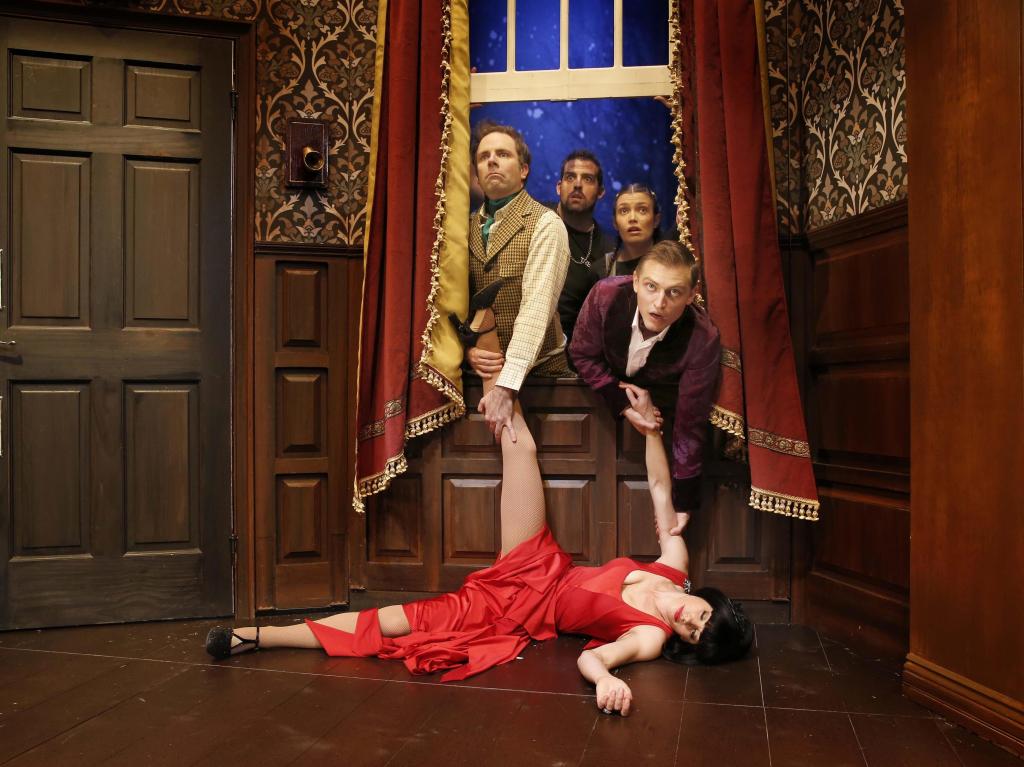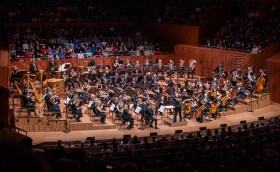Luke Joslin, Adam Dunn, Tammy Weller and Darcy Browne in The Play That Goes Wrong. Photograph supplied.
The Play that Goes Wrong is the new darling of the London’s West End and New York’s Broadway and it arrived in Australia this week. It is playing at Melbourne’s Comedy Theatre until 27 March and then tours Adelaide, Sydney and Perth.
This play was devised, written and performed three years ago in London by a trio of young actors Henry Lewis, Jonathan Sayer and Henry Shields who were, at the time, working minimum-wage cafe jobs. In light hearted mode they decided to create a show rather than waiting around for the next audition. Fresh and funny, and picking up three major theatre awards, including the Olivier Award in 2015, the three appear to have struck the jackpot with their comedy show.
It is a slapstick comedy derived from the English public school humour drawing room farce traditions of Noel Coward, John Cleese and Michael Frayn (writer of the hit classic Noises Off) combined with a twist of the physical comedy of the silent film era.
It was originally performed by the writers themselves and three other actors in the Red Lion Theatre in London which is a 60-seat venue above a pub. Devoured by its audiences, it became sought out by a Broadway producer and has become a different proposition from its first incarnation.
Originally in London the show was an hour long, in an intimate setting where the actors were in one or two metres from their audience.
“When it was at the Old Red Lion the main fun was that you could see the whites of the actors eyes,” said Sayer. “Because of that it felt really dangerous and spontaneous. We’ve been really keen to make sure it still has that fun, live, exciting energy.”
At the Comedy Theatre the new version is an extended two and a quarter hour performance, seen here with an Australian cast (excellent and professionally impeccable) acting other people’s gags in a theatre with a proscenium arch, raised stage and a auditorium which demands expert voice projection; no quietly spoken asides carry here. Double the length to its original conception, the show is left lack lustre by some comic timing that was achingly slow. I suspect that the chemistry and specificity of the clowning to the original devisors has left us with a rather watered down version of what this play began life as.
The Play that Goes Wrong is a play within a play, The Cornley Polytechnic Drama Society endeavour to stage ‘The Murder at Haversham Manor‘ a stuffy Agatha Christie-style murder mystery.
The Cornley Polytechnic tell us that their previous productions have been somewhat limited by issues around cast numbers and props; last year they did their version of a westend musical called Cat and a Roald Dahl production called ‘James, where is your P each?’.
The play follows an amateur production by well-meaning young thespians as they navigate their way through an evening of chaos: of fragile stage sets (in a state of complete collapse by the end of second half), sticking doors, faulty stage effects, fluffed lines, missing props, physical faux pas, collisions, accidents and mishaps.
The Australian cast are in fine fettle and display full commitment to breathing life into the show. Brooke Satchwell and Adam Dunn mix with the audience in the stalls before the show begins, enquiring about a lost spaniel. Darcy Brown is a splendid earnest ‘Jonathan’ and does some beautifully understated work as a corpse attempting to follow its exit and entry cues. James Marlowe, Nick Simpson-Deeks, Tammy Weller, Luke Josline and George Kemp all hold the stage in a united show of expertise.
My favourite character and performance was ‘Trevor’, a techy who sits dimly lit in one of the theatre boxes throughout the performance, bored and expressing exasperation at what he sees unfolding below him. Playing with his rubiks cube, drinking beer and eating snacks, occasionally all eyes drift up to him as the cast of the play stand frozen awaiting a crucial sound effect he has forgotten. Putting down his beer he rushes to the rescue with a flick of a switch. Adam Dunn seemed to be the character who broke ‘the third wall’ most successfully and connected with the audience, which is what this show seemed to largely struggle with for me.
I found the presentation of the female characters limited and tedious, yes I know hysterical melodrama is a parody of ‘woman’ but it is still an old, overused and offensive one. The structure and design of the show pertains to a production uninformed by female, non-white contribution. The writers have played with the idiom of white, male, middle class, heterosexual dominant theatrical discourse but they don’t subvert it.
The Play that went Wrong is populist theatre perfect for the tourist audiences of London and New York; it does not broach any contentious issue, contest any stereo-types and it’s humour rests in physical gags. Whether it will satisfy the more local audiences of Australia is yet to be seen.
Admittedly however, slapstick, clowning, mime, physical stunts and making funny faces have been making people laugh for hundreds of years: Mr Bean testifies to its continuing appeal. Last night at the Comedy Theatre the convivial, heavily imbibing audience around me laughed heartily throughout The Play that Goes Wrong, and I did too, sometimes.
2 stars





